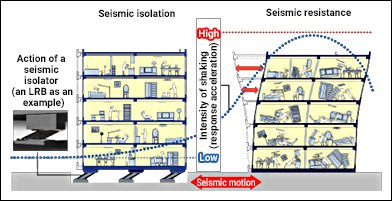This website uses cookies for a better browsing experience.
If you agree to the use of cookies, please click the "Agree" button.
Please refer to the Privacy Policy regarding the use of cookies on this site.
What is seismic isolation?
Vibration control is the key to seismic isolation.
Seismic isolation is a method of construction that separates the building from the ground. Seismic isolators are installed to prevent seismic tremors from being transmitted to the building, thereby keeping the building safe.
Seismic isolation dampens the force of an earthquake and converts it into slower shaking, thus protecting not only the building itself but also its interior.
The natural period of a seismically isolated building
Seismic isolation lengthens the natural period of a building by means of a seismic isolator, thereby avoiding resonance with seismic motion and further reducing seismic shaking to 1/3 to 1/5 of its original value.

The natural period of a seismic-resistant building
In contrast, seismic resistance is a method of construction that attempts to resist seismic forces by increasing the rigidity of the building.
When the period of earthquake shaking coincides with the natural period of the building, seismic resistance produces a resonance phenomenon, amplifying the shaking of the building by a factor of three to five.
The structure of the building itself will be protected, but there is a possibility of a secondary disaster due to falling furniture and damage to finishing materials inside the building.

An image comparing shaking with seismic isolation and seismic resistance
Seismic isolation and seismic resistance differ greatly in terms of building deformation and damage within the building, as shown in the figure on the right.


The many advantages of seismic isolation
| Improved safety | Seismic isolation precludes damage to the building as well as internal furnishings, and gas or water leaks do not occur. It prevents secondary damage from falling furniture and saves lives. |
|---|---|
| Maintaining functionality | The functionality of the building is not hampered even in the event of a major earthquake, and normal life can continue. |
| Protection of property | The difficulty of repairing, reinforcing, demolishing, and rebuilding after an earthquake was already experienced following the Great Hanshin-Awaji Earthquake. This is not a concern with seismic isolation. |
| Greater freedom | Seismic inputs to the building can be significantly reduced, allowing for greater flexibility in planning. Precast construction, including joints, can be simplified and members can be lighter. |
| Greater peace of mind | The psychological strain of an earthquake is greatly reduced by eliminating anxiety over earthquakes. An evacuation route is available after an earthquake. |
| The cost and advantages of seismic isolation |
Seismic isolation has a smaller life-cycle cost since it reduces earthquake damage and eliminates the need for post-quake repair costs. |
Forms of seismic isolation
Seismic isolation of the foundation/inter-story seismic isolation
Seismic isolation is a method of construction that separates the building from the ground. Seismic isolators are installed to prevent seismic tremors from being transmitted to the building, thereby keeping the building safe. Seismic isolation reduces the force of an earthquake and converts it into slower shaking, thus protecting not only the building itself but also its interior.
Seismic isolation of the foundation installs seismic isolators at the foundation of the building, so the entire building is seismically isolated.
Seismic isolation between floors installs seismic isolators on pillars and other places between floors when there is little clearance from the property line. Floors above seismically isolated floors are seismically isolated.
For more information on the movement of seismically isolated buildings and seismic isolators, please watch this video.

Seismic reinforcement (retrofitting)
Seismic reinforcement typically involves installing earthquake-resistant walls and reinforcing columns and beams in a building. In contrast, construction with seismic isolators (retrofitting) improves seismic resistance with as little modification to the building as possible. This has numerous advantages, including the ability to preserve the original artistry of historic structures and cultural assets and the ability to reinforce the building while it is still in use.









